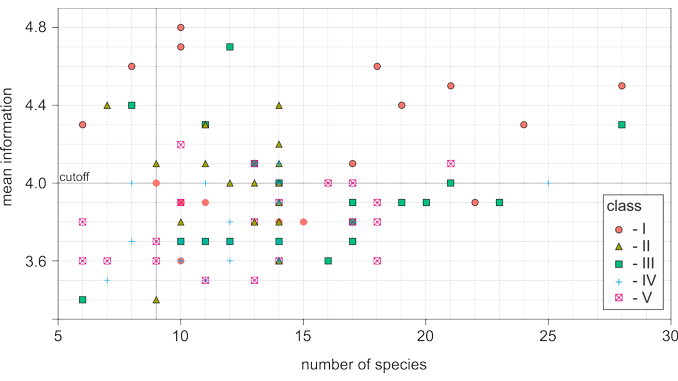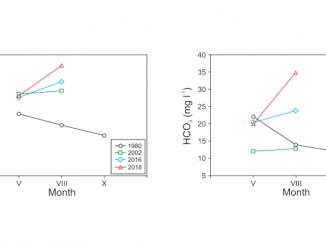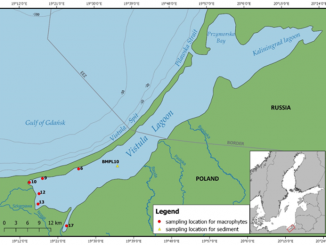
Paper category: Original research paper
Corresponding author: Anna Budka (anna.budka@up.poznan.pl)
DOI: 10.2478/ohs-2019-0001
Received: 12/03/2018
Accepted: 31/07/2018
Full text: here
Citation (APA style): Budka, A. (2019). How many indicator species are required to assess the ecological status of a river? Oceanological and Hydrobiological Studies, 48(1), 1-12. doi:10.1515/ohs-2019-0001
Abstract
The presented research focused on macrophytes, which constitute a primary element in the assessment of the ecological status of surface waters following the guidelines of the Water Framework Directive. In Poland, such assessments are conducted using the Macrophyte Index for Rivers (MIR). The objective of this study was to characterize macrophyte species in rivers in terms of their information value in the assessment of the ecological status of rivers. The macrophyte survey was carried out at 100 river sites in the lowland area of Poland. Botanical data were used to verify the completeness of samples (the number of taxa). In the presented research, the information provided by each species was controlled. Entropy was used as the main part of information analysis. This analysis showed that the adoption of a standard approach in the studies of river macrophytes is likely to provide sample underestimation (with missing species). This may potentially lead to incorrect determination of MIR and thus result in a wrong environmental decision. On this basis, a sample completeness criterion was developed. Using this criterion, the average value of information for macrophyte species in medium-sized lowland rivers is sufficient to be considered representative.
References
Bernatowicz, S. & Wolny, P. (1969). Fisherman’s botany. Państwowe Wydawnictwo Rolnicze i Leśne, Warszawa, Poland. (In Polish).
Bis, B. & Mikulec, A. (2013). Guide to assess the ecological status of rivers based on benthic macroinvertebrates. Warszawa: Biblioteka Monitoringu Środowiska. (In Polish).
Błachuta, J. & Picińska-Fałtynowicz, J. (2010). Methodological guidelines for assessing the ecological status of water bodies of rivers and lakes as well as the ecological potential of artificial and heavily modified homogeneous parts of flowing waters of Poland based on phytobenthos research. Wrocław: GIOŚ. (In Polish).
Błachuta, J. & Picińska-Fałtynowicz, J. (2012). Methodological guidelines for conducting phytoplankton tests and assessing the ecological status of rivers on its basis. Warszawa: GIOŚ. (In Polish).
Bremer, M. & Cohnitz, D. (2004). Information and information flow – an introduction. Frankfurt: Ontos Verlag.
Budka, A. (2018). Determining the change point for the error in the Macrophyte Index for Rivers. Biom. Lett. 55(2): 215–232. DOI: 10.2478/bile-2018-0015.
Carvalno, L.B., Rojano-Delgado, A.M, Costa Aguiar Alves, P.L. & Prado, R. (2013). Differential content of glyphosate and its metabolites in Digitaria insularis biotypes. Com. Plant. Sci. 3(3–4): 17–20. DOI: 10.26814/cps201317.
Ceschin, S., Salerno, G., Bisceglie, S. & Kumbaric, A. (2010). Temporal floristic variations as indicator of environmental changes in the Tiber River in Rome. Aquat. Ecol. 44: 93–100. DOI: 10.1007/s10452-009-9292-1.
Chojnicki, Z. & Czyż, T. (1991). Spatial diversity of the level and living conditions of the population. Warszawa: Biuletyn KPZK PAN. p. 153. (In Polish).
Cover, T.M. & Thomas, J.A. (1991). Elements of Information Theory. Wiley Series in Telecommunications.
Dawson, F.H. (1988). Water flow and the vegetation of running waters. In J.J. Symoens (Ed.), Vegetation of inland waters (pp. 283–309). Dordrecht: Kluwer Academic Publishers.
Directive, 2000/60/EC. Directive 2000/60/EC of the European Parliament and of the Council of 23 October 2000 establishing a framework for Community action in the field of water policy.
Eryomin, A.L. (1998). Information ecology – a viewpoint. Int. J. Environ. Stud. Sections A&B 3/4: 241–253. DOI: 10.1080/00207239808711157.
Dudley, S.A., Murphy, G.P. & File, A.L. (2013). Kin recognition and competition in plants. Func. Ecol. 27: 898–906. DOI: 10.3732/ajb.0900006.
Groen, C.L.G., Stevers, R.A.M., Van Gool, C.R. & Broekmeyer, M.E.A. (1993). Elaboration of the ecotope system. Phase III, CML report, p. 49.
Haslam, S.M. (1982). A proposed method for monitoring river pollution using macrophytes. Environ. Technol. Lett. 3: 19–34. DOI: 10.1080/09593338209384094.
Haury, J., Peltre, M.C., Trémolières, M., Barbe, J., Thiébaut, G. et al. (2006). A new method to assess water trophy and organic pollution – the Macrophyte Biological Index for Rivers (IBMR): its application to different types of river and pollution. Hydrobiologia 570: 153–158. DOI: 10.1007/978-1-4020-5390-0_22.
Henderson, D.W. (1963). Venn diagrams for more than four classes. Amer. Math. Monthly 70: 424–426. DOI: 10.2307/2689288.
Holmes, N.T.H., Newman, J.R., Chadd, S., Rouen, K.J., Saint, L. et al. (1999). Mean trophic rank: a user’s manual R D. In Technical report no E38 Environmental Agency of England Wales. Bristol: UK.
Hutcheson, K. (1970). A test for comparing diversities based on the Shannon formula. J. Theor. Biol. 29: 151–154. DOI: 10.1016/0022-5193(70)90124-4.
Jones, G.A. & Jones, M.J. (2000). Information and Coding Theory. Springer.
Jusik, S (2012). Identification key to mosses and water liverwords required to the ecological status assessment of surface waters in Poland. Biblioteka Monitoringu Środowiska, Warszawa, Poland. (In Polish).
Klijn, F. (1994). Spatially nested ecosystems: guidelines for classification from a hierarchical perspective. In F. Klijn (Ed.), Ecosystem Classification for Environmental Management (pp. 85–116). Ecology & Environment 2, Dordrecht: Springer, Kluwer.
Klijn, F. (1989). Landscape ecological mapping of the Netherlands: groundwater relations. CML report, p. 51.
Kolada, A., Hellsten, S., Søndergaard, M., Mjelde, M., Dudley, B. et al. (2011). Report on the most suitable lake macrophyte based assessment methods for impacts of eutrophication and water level fluctuations.
Kondracki, J. (1995). Physico-geographical regionalization. In Encyclopedia of world geography. Eastern Europe, North and Central Asia, Transcaucasia (pp. 31–34). Wiedza Powszechna, Warszawa.
Kullback, S. (1959). Information theory and statistics. John Wiley and Sons, Inc., New York; Chapman and Hall, Ltd., London.
Lewin, I., Czerniawska-Kusza, I., Szoszkiewicz, K., Ławniczak, A.E. & Jusik, S. (2013). Biological indices applied to benthic macroinvertebrates at reference conditions of mountain streams in two ecoregions (Poland, the Slovak Republic). Hydrobiologia 709: 183–200. DOI: 10.1007/s10750-013-1448-2.
Li, M. & Vitanyi, P. (1997). An Introduction to Kolmogorov Complexity and Its Applications. Springer.
Loga, M. & Wierzchołowska-Dziedzic, A. (2017). Probability of misclassifying biological elements in surface waters. Environ. Monit. Assess. 189: 647. DOI: 10.1007/s10661-017-6368-6.
Loga, M. (2012). Hierarchical approach to water body status misclassification. Water Pollution XI Book Series: WIT Transactions on Ecology and the Environment. WIT Press 164: 97–109. DOI: 10.2495/WP120091.
MacKay, D.J.C. (2003). Information Theory, Inference, and Learning Algorithms. Cambridge University Press, 2003.
Mazur, M. (1970). Qualitative information theory. WNT, Warszawa, p. 223. (In Polish).
Mischke, U., Venohr, M. & Behrendt, H. (2011). Using phytoplankton to assess the trophic status of German rivers. Int. Rev. Hydrobiol. 95: 578–598. DOI: 10.1002/iroh.201111304.
Parysek, J.J. & Wojtasiewicz, L. (1979). Methods of regional analysis and regional planning methods. Stud. KPZK PAN, p. 69. (In Polish).
Rimet, F. & Bouchez, A. (2012). Biomonitoring river diatoms: implications of taxonomic resolution. Ecol. Indic. 15(1): 92–99. DOI: 10.1016/j.ecolind.2011.09.014.
Ruskey, F., Savage, C. & Wagon, S. (2006). The search for simple symmetric Venn diagrams. Not. Am. Math. Soc. 53: 1304–1312. DOI: 10.1.1.74.8980.
Rutkowski, L. (2008) Identification key to vascular plants of Polish Lowland. Wydawnictwo Naukowe PWN, Warszawa, Polska. (In Polish).
Shannon, C.E. & Weaver, W. (1949). The mathematical theory of communication. Univ. Illinois Press, London and New York.
Sherwin, W.B., Chao, A., Jost, L. & Smouse, P.E. (2017). Information theory broadens the spectrum of molecular ecology and evolution. Trends in Ecology and Evolution 32: 948–963. DOI: 10.1016/j.tree.2017.09.012.
Smith, D. (1972). Geography and social indicators. S. Afr. Geogr. J. 54: 43–57. DOI: 10.1080/03736245.1972.10559497.
Sobala-Gwosdz, A. (2004). The change in the rural standard of living during the transformation period in the Podkarpackie Province, Poland, IGiGP Warsaw 114: 93–106.
Staniszewski, R. & Szoszkiewicz, J. (2006). Impact of water level fluctuations on the water quality of a shallow lake – spring and summer studies. Verhandlungen des Internationalen Verein Limnologie 29: 2087–2088. DOI: 10.1080/03680770.2006.11903059.
Staniszewski, R., Szoszkiewicz, K., Zbierska, J., Leśny, J., Jusik, S. et al. (2006). Assessment of sources of uncertainty in macrophyte surveys and the consequences for river classification. Hydrobiologia 566: 235–246. DOI: 10.1007/s10750-006-0093-4.
Szoszkiewicz, K. (2013). Macrophyte River Assessment Method. In H. Ciecierska & M. Dynowska. Biological methods for assessing the state of the environment. Water ecosystems Tom II. (pp. 81–96). Olsztyn: Wydawnictwo Mantis. (In Polish).
Szoszkiewicz, K., Budka, A., Pietruczuk, K., Kayzer, D. & Gebler, D. (2017) Is the macrophyte diversification along the trophic gradient distinct enough for river monitoring? Environmental Monitoring and Assessment 189: 4. DOI: 10.1007/s10661-016-5710-8.
Szoszkiewicz, K., Jusik, S., Zgola, T., Czechowska, M. & Hryc, B. (2007). Uncertainty of macrophyte-based monitoring in different river types. Belg. J. Bot. 140: 7–16. DOI: 10.2307/20794619.
Szoszkiewicz, K., Zbierska, J., Jusik, S. & Zgoła, T. (2010). A macrophyte river assessment method. Manual for the assessment and classification of rivers based on aquatic plants. Bogucki Wydawnictwo Naukowe, Poznań. (In Polish).
Westlake, D.F. (1975). Macrophytes. In B.A. Whitton (Ed.) River ecology (pp. 106–128). University of California Press, Berkeley.
WFD Intercalibration. (2011). Phase 2: Milestone report – October 2011. European Commission Directorate General, JRC Joint Research Centre, Institute of Environment and Sustainability. JRC documents, pp. 105.
Wiegleb, G. (1979). Der Zusammenhang zwischen Gewässergüte und Makrophyten Vegetation in niedersächsischen Fließgewässern. Landschaft + Stadt 11: 32–35.



Bądź pierwszy, który skomentuje ten wpis